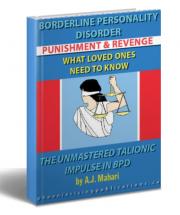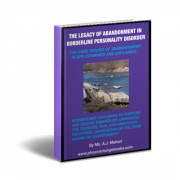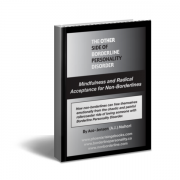Self Harm In Borderline Personality
Self harm in many ways and shapes and forms is a classic struggle for those diagnosed with Borderline Personality Disorder. The very types of self harm, that are, in so many ways, attempts on the part of the borderline to cope with dysregulated emotions and his or her own abandoned pain - pain that is the legacy of abandonment in BPD are in many ways what keeps the borderline stuck in the active throes of BPD and all of its pain and suffering. - A.J. Mahari
Self-injurious behavior is common in, but not limited to, the following conditions:
- Borderline Personality Disorder
- Mood Disorders
- Eating Disorders
- Obsessive-Compulsive Disorder
- Post-Traumatic Stress Disorder
- Dissociative Disorders
- Anxiety and/or Panic
- Impulse-control Disorder Not Otherwise Specified
Self-injury itself as a diagnosis
Favazza and Rosenthal, in a 1993 article in Hospital and Community Psychiatry, suggest defining self-injury as a disease and not merely a symptom. They created a diagnostic category called Repetitive Self-Harm Syndrome.
The diagnostic criteria for Repetitive Self-Harm Syndrome include:
- preoccupation with physically harming oneself
- repeated failure to resist impulses to destroy or alter one's body tissue
- increasing tension right before, and a sense of relief after, self-harm
- no association between suicidal intent and the act of self-harm
- not a response to mental retardation, delusion, hallucination
Miller (1994) suggests that many self-harmers suffer from what she calls Trauma Reenactment Syndrome.
As described in Women Who Hurt Themselves, TRS sufferers have four common characteristics:
- a sense of being at war with their bodies ("my body, my enemy")
- excessive secrecy as a guiding principle of life
- inability to self-protect (often seen in a specific kind of fragmentation of self
- relationships dominated by a struggle for control.
Miller proposes that women who've been traumatized suffer a sort of internal split of consciousness; when they go into a self-harming episode, their conscious and subconscious minds take on three roles:
- the abuser (the one who harms)
- the victim
- the non-protecting bystander
Favazza, Alderman, Herman (1992) and Miller suggest that, contrary to popular therapeutic opinion, there is hope for those who self-injure. Whether self-injury occurs in tandem with another disorder or alone, there are effective ways of treating those who harm themselves and helping them find more productive ways of coping.
Varieties of Self-Harm
Self-injury is separated by Favazza (1986) into three types. Major self-mutilation (including such things as castration, amputation of limbs, enucleation of eyes, etc) is fairly rare and usually associated with psychotic states. Stereotypic self-injury comprises the sort of rhythmic head-banging, etc, seen in autistic, mentally retarded, and psychotic people. The most common forms of self-mutilation include:- cutting
- burning
- scratching
- skin-picking
- hair-pulling
- bone-breaking
- hitting
- deliberate overuse injuries
- interference with wound healing
- and virtually any other method of inflicting damage on oneself
Other methods of self harm that I would add here that are less talked about and often not thought about as self harm as often by those with BPD include:
- addiction to alcohol
- addiction to drugs
- risky Sexual Encounters
- compulive over-eating - eating to soothe
- compulsive Under-eating - anorexia
- judging oneself
- negative patterns of thinking
- always expecting the worst
- picking fights with others
- creating conflict intentionally
- refusal to take personal responsibility
Compulsive self-harm
Favazza (1996) further breaks down superficial/moderate self-injury into three types: compulsive, episodic, and repetitive. Compulsive self-injury differs in character from the other two types and is more closely associated with obsessive-compulsive disorder (OCD). Compulsive self-harm comprises hair-pulling (trichotillomania), skin picking, and excoriation when it is done to remove perceived faults or blemishes in the skin. These acts may be part of an OCD ritual involving obsessional thoughts; the person tries to relieve tension and prevent some bad thing from happening by engaging in these self-harm behaviors. Compulsive self-harm has a somewhat different nature and different roots from the impulsive (episodic and repetitive types).Impulsive self-harm
Both episodic and repetitive self-harm are impulsive acts, and the difference between them seems to be a matter of degree. Episodic self-harm is self-injurious behavior engaged in every so often by people who don't think about it otherwise and don't see themselves as "self-injurers." It generally is a symptom of some other psychological disorder.
What begins as episodic self-harm can escalate into repetitive self-harm, which many practitioners (Favazza and Rosenthal, 1993; Kahan and Pattison, 1984; Miller, 1994; among others) believe should be classified as a separate Axis I impulse-control disorder.
Repetitive self-harm is marked by a shift toward ruminating on self-injury even when not actually doing it and self-identification as a self-injurer (Favazza, 1996). Episodic self-harm becomes repetitive when what was formerly a symptom becomes a disease in itself. It is impulsive in nature, and often becomes a reflex response to any sort of stress, positive or negative.Should self-injurious acts be considered botched or manipulative suicide attempts?
Favazza (1998) states, quite definitively, that ... self-mutilation is distinct from suicide. Major reviews have upheld this distinction . . . A basic understanding is that a person who truly attempts suicide seeks to end all feelings whereas a person who self-mutilates seeks to feel better. Although these behaviors are sometimes referred to as parasuicide most researchers recognize that the self-injurer generally does not intend to die as a result of his/her acts. Many professionals continue to define acts of self-harm as merely and totally being symptomatic of Borderline Personality Disorder instead of considering that they may well be disorders in their own right.
Many of those who injure themselves are strongly aware of the fine line they walk, but are also resentful of doctors and mental health professionals who define their incidents of self-harm as suicide attempts instead of seeing them as the desperate attempts to release the pain that needs to be released in order to not end up suicidal.
Please note: Some of the poems, expressions and/or articles in this section are very blunt and may be disturbing so use your best judgment or caution when choosing to read anything below.
- Art of Blood-letting - self-mutilation
- Self Harm How I started it and ended it
- Poems Self Harm By Rayne
The False Self in BPD is at the heart of so much of what causes those with BPD to self harm.
The borderline false self is the root of Rage in BPD A rage that the borderline false self via its narcissism employs to try to protect the borderline from his or her Abandoned Pain. --© A.J. Mahari
A.J. Mahari is currently writing a memoir about her life and experience as a person who had two parents with Borderline Personality Disorder, as a person who was diagnosed herself with BPD at the age of 19 and from her perspective as someone who has recovered from BPD. There is a new section on her BPD Blog called The Diary - My Borderline Years
Audio Program "Preparing For Recovery From BPD" Parts 1 & 2 by A.J. Mahari
Audio Program Rage Addiction in BPD by A.J. Mahari (sold separately or packaged with Mahari's Ebook, "Rage and BPD")
- Purchase all 3 of ebooks for NON BORDERLINES
- Non Borderlines - You can purchase 6 ebooks packaged together with or without audio.
- Those with BPD and/or Non Borderlines can purchase A.J. Mahari's 3 "Core Wound of Abandonment" series ebooks packaged together with or without audio.

















